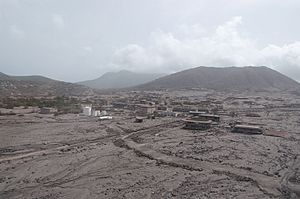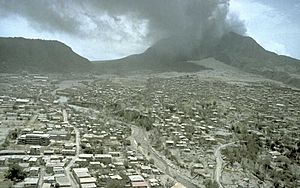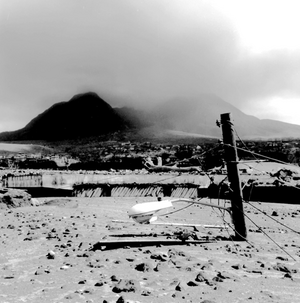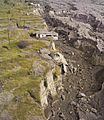Plymouth, Montserrat facts for kids
Quick facts for kids
Plymouth
|
|
|---|---|
|
Abandoned town
|
|

Plymouth in 2006, following the 1997 eruptions which buried most of the town in ash
|
|
| Country | |
| Overseas territory | |
| Population
(2016)
|
|
| • Total | 0 |
| 4,000 inhabitants before evacuation as a result of volcanic eruption | |
| Time zone | UTC-4 (Atlantic) |
Plymouth is a ghost town located on the island of Montserrat. Montserrat is an overseas territory of the United Kingdom. It is found in the Leeward Islands chain, part of the Lesser Antilles in the Caribbean.
Plymouth was built on old lava deposits. These were near the Soufrière Hills volcano, which had been quiet for a very long time. In 1995, the volcano started erupting again. The town was evacuated for safety. Plymouth was completely abandoned in 1997. This happened after it was badly burned and buried by hot ash and mudflows. For many centuries, Plymouth was the only port where people could enter the island. Even today, Plymouth is still the official capital of Montserrat. This makes it the only ghost town that is also a capital city.
Contents
History of Plymouth
Volcano Awakens: Eruptions and Evacuation

In July 1995, the Soufrière Hills volcano began to erupt. It had been inactive for hundreds of years. Huge eruptions sent hot, fast-moving clouds of gas and ash, called pyroclastic flows, across southern Montserrat. Ash also fell over a wide area, including Plymouth. It quickly became clear that the town was in great danger.
On August 21, 1995, ash fell on Plymouth. In December, residents were moved out as a safety step. People were allowed to return a few months later. However, on June 25, 1997, another massive eruption happened. This eruption created more pyroclastic flows. They sadly killed 19 people. These flows almost reached the island's airport. Plymouth was evacuated again after this event.
Town Buried: The Final Blow
Between August 4 and 8, 1997, more large eruptions occurred. These eruptions destroyed about 80% of Plymouth. The town was buried under about 1.4 meters (4.6 feet) of ash. This hot material burned many buildings. It made it almost impossible for people to live there.
The volcanic material, like ash and lava, was very dense. It was as hard as concrete. Removing this heavy layer would have been very difficult. It would have needed explosives and bulldozers. These tools were too expensive for such a large area. Experts also believed the soil beneath the hardened mud and lava would be scorched. This meant it would not be able to grow crops.
Life After the Eruption: A New Beginning
The government ordered everyone to leave Plymouth. The British navy helped by taking people to safety. The entire southern part of the island was declared an exclusion zone. This means no one is allowed to enter it. This zone is still in place today because the volcano is still active.
The island's government moved north to the town of Brades. However, Plymouth officially remains the capital. As of 2013, a new port and capital are being built. This new area is called Little Bay. It is on the island's northwest coast.
The destruction of Plymouth caused big economic problems for Montserrat. Plymouth was the island's largest town. It had about 4,000 people living there. Most of the island's shops and services were in Plymouth. It was also where the government was located. Some lost facilities were rebuilt in other parts of Montserrat. But many people still had to leave the island. Between 1995 and 2000, two-thirds of the island's population left. Many moved to the United Kingdom. By 1997, fewer than 1,200 people lived on the island. By 2016, the population had grown to almost 5,000 again.
Images for kids
See also
 In Spanish: Plymouth (Montserrat) para niños
In Spanish: Plymouth (Montserrat) para niños










